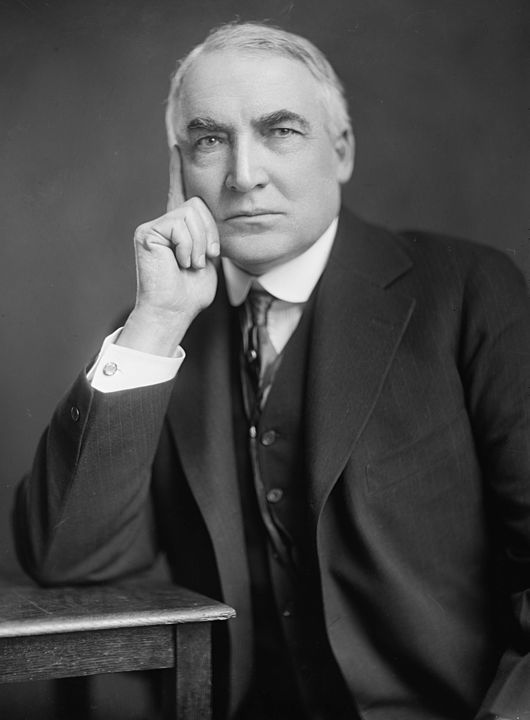At the age of 14, Warren Harding attended Ohio Central College, where he became an experienced public speaker and edited the campus newspaper. He taught at a country school after graduation in 1882 and sold insurance. The same year, the nearly defunct Marion Daily Star newspaper in Marion, Ohio, was acquired by him and two friends. The paper suffered for a time under Warren Harding’s influence but later prospered, due in part to the good-natured manner and strong sense of Harding community.
He married Florence Kling De Wolfe seven years later, and she proved instrumental in turning The Marion Star into a daily paper that was financially successful. Soon, Warren Harding joined the leading corporate boards and fraternal organizations, a man of little discernible intelligence or imagination. He was drawn into Republican Party politics as he started to associate with the state’s movers and shakers. Harding, a handsome man who had always been well dressed and well-groomed, looked like a leader. Rather than any internal qualities, his outward appearance most strongly contributed to his political success.
Early Political Career
He started his political career in 1898, at the urging of his wife. He won a seat in the Ohio legislature that year and served two terms afterward. Harding did favors for city bosses, an unwavering conservative Republican with a lively speaking accent, which in turn helped him advance in Ohio politics. He became lieutenant governor in 1903 and served for two years in that position before returning to the newspaper business.
Warren Harding won an election to the U.S. after an unsuccessful bid for the governorship in 1910. Senate in a hard-fought campaign four years later. He strongly supported corporate interests as a senator and favored protective tariffs. Like other Republicans at the time, he rejected the “Fourteen Points” peace initiative of Woodrow Wilson and advocated prohibition. Though he had strong opinions on the day’s key issues, he was also not directly involved in the legislative process. Warren Harding missed two-thirds of the votes held during his time as a senator, including the vote on women’s suffrage, a cause he strongly supported, according to his Congressional voting record.
Presidential Race
Delegates stalled their option for a presidential nominee at the 1920 Republican National Convention and finally chose Harding as a candidate for compromise. The Massachusetts governor, Calvin Coolidge, was selected as his vice-presidential running mate. As their presidential nominee, the Democrats chose James Cox, the governor of Ohio; Franklin Roosevelt, the Navy and eventual 32nd president of the United States, was selected as his running mate.
The pro-business Harding promoted a “return to normalcy” in the wake of World War I and the social reforms of the Revolutionary Period. He conducted a front-porch campaign in Marion from his house, and thousands of people traveled there to hear him speak.
The Harding-Coolidge ticket defeated the Democrats in the general election in the biggest landslide up to that time, winning some 60% of the popular vote and a 404-127 electoral lead. It was the first presidential election that women in the United States could vote in, having secured the right in August 1920 with the ratification of the 19th Amendment.
Warren Harding as a President
When Congress completed an initiative started by Woodrow Wilson’s administration and set up a budget system for the federal government, the administration got off to a good start; Charles G. Dawes was appointed the first director of the budget. The United States then hosted the Washington Naval Disarmament Conference in 1921-1922.
A combination of excellent leaders and unscrupulous politicians waiting for an opportunity to line their pockets were appointed to his cabinet. Secretary of State Charles Evans Hughes and Commerce Secretary Herbert Hoover were in the first group. Attorney General Harry Daugherty and Interior Secretary Albert B. Fall were in the second. Harding was a famously weak judge of character who wanted his appointees with honesty to repay his confidence. He should have been profoundly disappointed.
Warren Harding followed a dominantly pro-business, conservative Republican agenda once in office. Taxes, especially for corporations and wealthy individuals, were lowered; high protective tariffs were enacted, and there was limited immigration. The 1921 Budget and Accounting Act, which simplified the federal budget structure and set up the General Accounting Office to audit government spending, was signed by Harding. Also, the United States held a fruitful conference for the world’s leading countries on naval disarmament.
Scandals involving Warren Harding
He was never directly involved in the scandals, but he was aware of Forbes, Smith, and the Ohio Gang’s actions and failed to light their corruption. The public started to view him as a man in the mid-1920s who clearly could not live up to his high office’s responsibilities. His reputation was further degraded by rumors of his heavy drinking in the White House when alcohol prohibition was a national law and his extramarital affairs role. Nan Britton published The President’s Daughter in 1927, in which she stated that a child fathered by the future president was born in 1919.
Death
Warren Harding engaged on a cross-country tour of the United States in 1923 to support his policies. The 57-year-old president became ill during the journey, and on August 2, he died of what was possibly a heart attack, and no autopsy was performed at a hotel in San Francisco.
Millions of citizens around the country gathered to pay their respects to Warren Harding along the railroad tracks as his body was returned to Washington, D.C. from the West Coast. Harding’s Marion home was later declared a National Historic Landmark and opened to the public. In Marion, the president’s tomb is also found.
US Presidents | ||

